1.7 Humanity faces some challenges in dealing with environmental issues.
Experts agree that if the Greenland Vikings had simply switched from cows to fish they might have avoided their own demise. Such a switch would have saved at least some of the pastureland, not to mention the tremendous amount of time and labour it took to raise cattle in such an ill-suited environment. But cows were a status symbol in Europe, beef was a coveted delicacy, and for reasons that still elude researchers, the Greenland Vikings had a cultural taboo against fish. It was a taboo they clung to, even as they starved to death.
11

“It’s clear that the Viking’s decisions made them especially vulnerable to the climatic and environmental changes that descended upon them,” says McGovern. “When you’re building wooden cathedrals in a land without trees, when you create a society reliant on imports in a situation where it’s difficult to travel back and forth to the homeland, when you absolutely refuse to collaborate with your neighbours in such a harsh, unforgiving environment, you are setting yourself up for trouble.” Ultimately, he says, the decisions this society made played as much of a role in its demise as the actual environmental changes did.
The problem, McGovern says, is not that the Greenland Vikings made so many mistakes in their early days, but that they were unwilling to change later on. “Their conservatism and rigidity, which we can see in many different aspects, seems to have kept them on the same path, maybe even prodded them to try even harder—build bigger churches, etc.—instead of trying to adapt.”
Decisions by individuals or groups that seem good at the time and produce a short-term benefit, but that hurt society in the long run, are called social traps. The tragedy of the commons is a social trap, first described by ecologist Garrett Hardin in 1968, that often emerges when many people are using a commonly held resource such as water or public land. Each person will act in a way to maximize his or her own benefit but as everyone does this, the resource becomes overused or damaged. Herders might put more animals on a common pasture because they are driven by the idea that “if I don’t use it, someone else will.” We do the same thing today as we overharvest forests and oceans or release toxins into the air and water. Other social traps include the time delay and sliding reinforcer traps—actions that, like the tragedy of the commons, have a negative effect later on. [infographic 1.6]
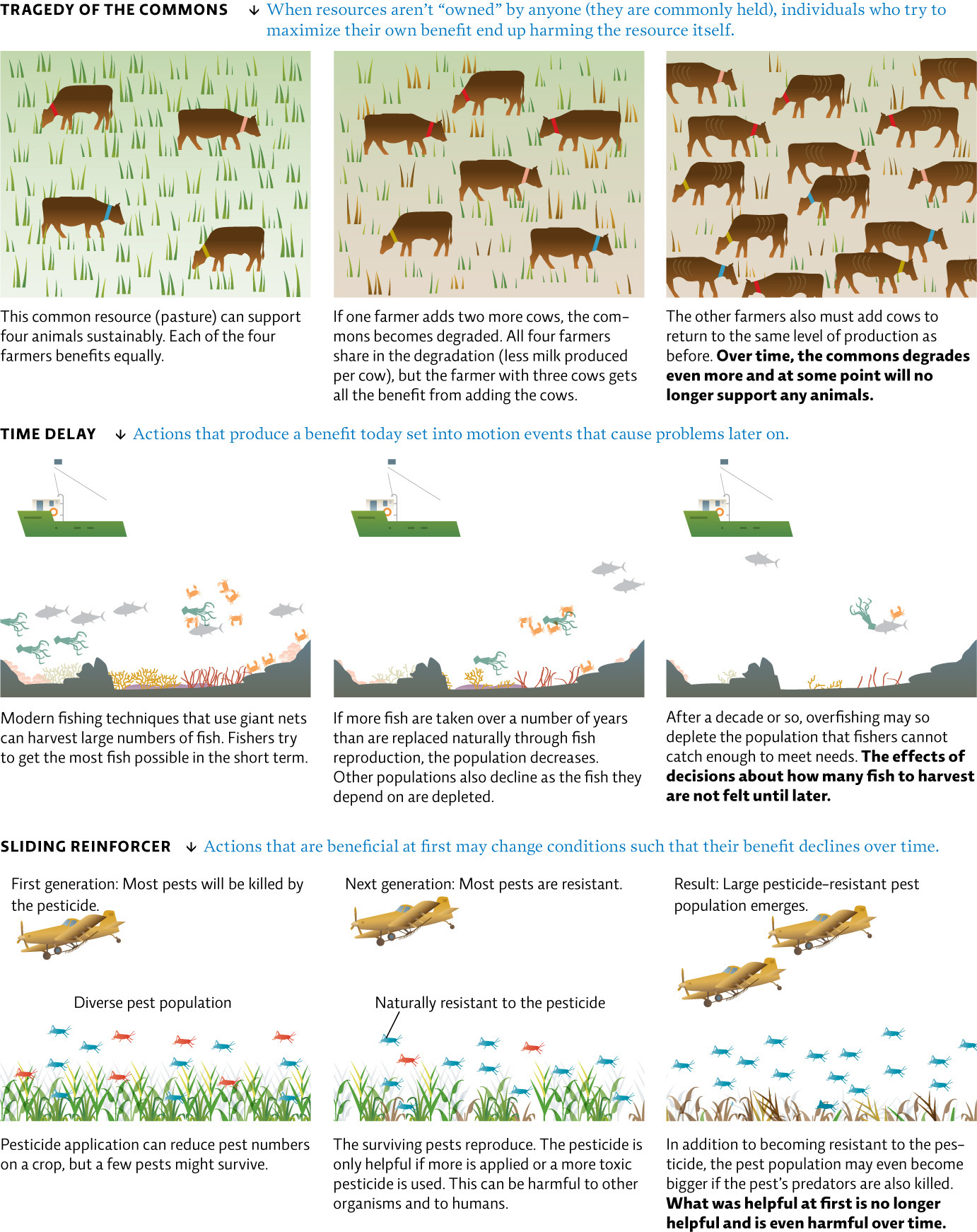
12
13
Education is our best hope for avoiding such traps. When people are aware of the consequences of their decisions, they are more likely to examine the trade-offs to determine whether long-term costs are worth the short-term gains and, hopefully, to make different choices when necessary. In Canada, environmental laws, such as the Canadian Environmental Protection Act and the Species at Risk Act, have gone a long way toward protecting our natural environment from various social traps, but enforcing those laws is a constant challenge.
Social traps are not the only challenge societies face. Another obstacle to sustainable growth is wealth inequality. In the Greenland Viking colony, wealth at first insulated the people in power from the environmental problems and they didn’t feel the strain of the decline until it was too late. Today, wealthier nations are less affected by resource availability, while 2 billion or more people lack adequate resources to meet their needs. In fact, just 20% of the population controls roughly 80% of all the world’s resources. On one hand, the affluent minority (of which Canada is a part) uses more than its share. Deep pockets allow us to exploit resources for wants, not just needs, and to exploit them all over the world, so that we can spare our own natural environments at the expense of someone else’s. For example, our demand for coffee and other luxury food and beverage products drives deforestation in Central and South America where the tree flourishes. Because we are far away from the trees, the environmental fall-out is easy to ignore at the moment, but as it did for the Vikings, it may reach a point where it affects everyone.
On the other hand, the underprivileged also exploit the environment in an unsustainable way. With limited access to external resources, they are often forced to over-exploit their immediate surroundings just to survive. The above example applies here, too. For an impoverished landowner in Costa Rica or Brazil, chopping down trees may be the only way she can feed her family—to her, harvesting the forest is more valuable than preserving it.
There are societal costs, as well, to this inequality. A growing gap between the haves and have-nots exacerbates tension and strife all over the world. In fact, fighting over resources has long been one of the contributing factors to societal decline and collapse. [infographic 1.7]
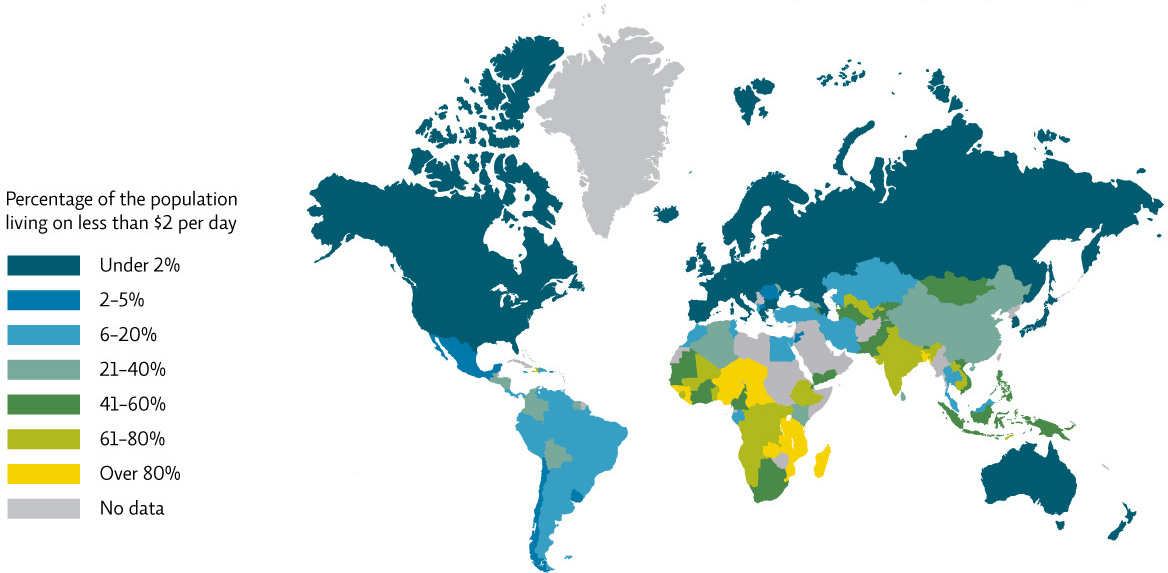
Conflicting worldviews are another challenge to sustainable living. Because our worldviews—the windows through which we view our world and existence—are influenced by cultural, religious, and personal experiences, they vary across countries and geographic regions, even within a society. People’s worldviews determine their environmental ethic, or how they interact with their natural environment; they also impact how they respond to environmental problems. When different people or groups, with different worldviews, approach environmental problems, they are bound to draw very different conclusions about how best to proceed.
14
The Vikings had an anthropocentric worldview—one where only human lives and interests are important. Other species meanwhile, were seen as having instrumental value—meaning the Vikings valued them only for what they could get out of them. Forests were nothing more than a source of timber; grasslands a source of home insulation and a feeding ground for cattle.
A biocentric worldview values all life. From a biocentric standpoint, every organism has an inherent right to exist, regardless of its benefit (or harm) to humans; each organism has intrinsic value. This worldview would lead us to be mindful of our choices and avoid actions that indiscriminately harm other organisms or put entire species in danger of extinction. An ecocentric worldview values the ecosystem as an intact whole, including all of the ecosystem’s organisms and the nonliving processes that occur within the ecosystem. Considering the same forests and grassland from an ecocentric worldview, the Vikings might have decided to protect both, not just for the resources they could harvest but to protect the complex processes that can produce those resources only when they remain intact. [infographic 1.8]
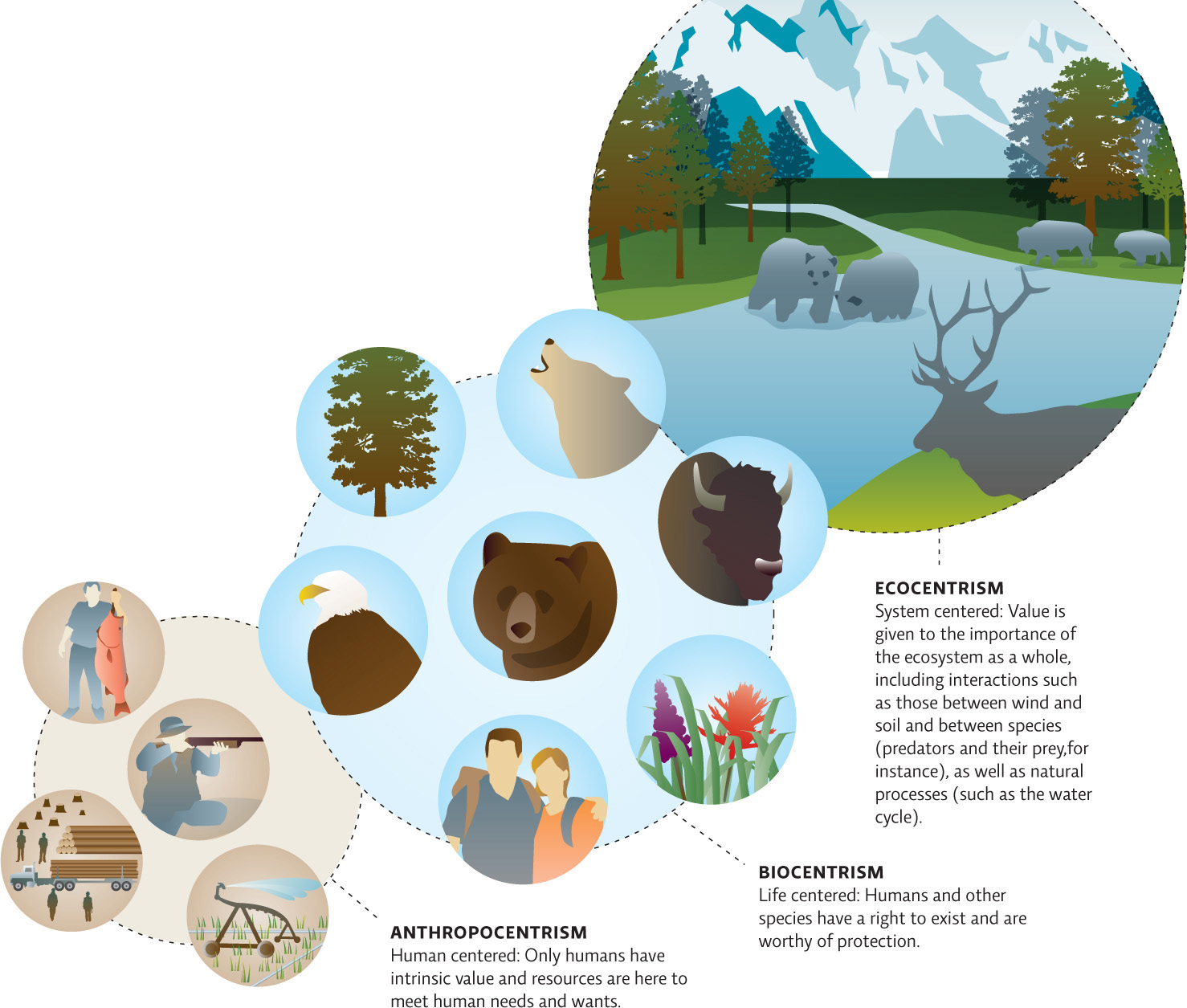
15
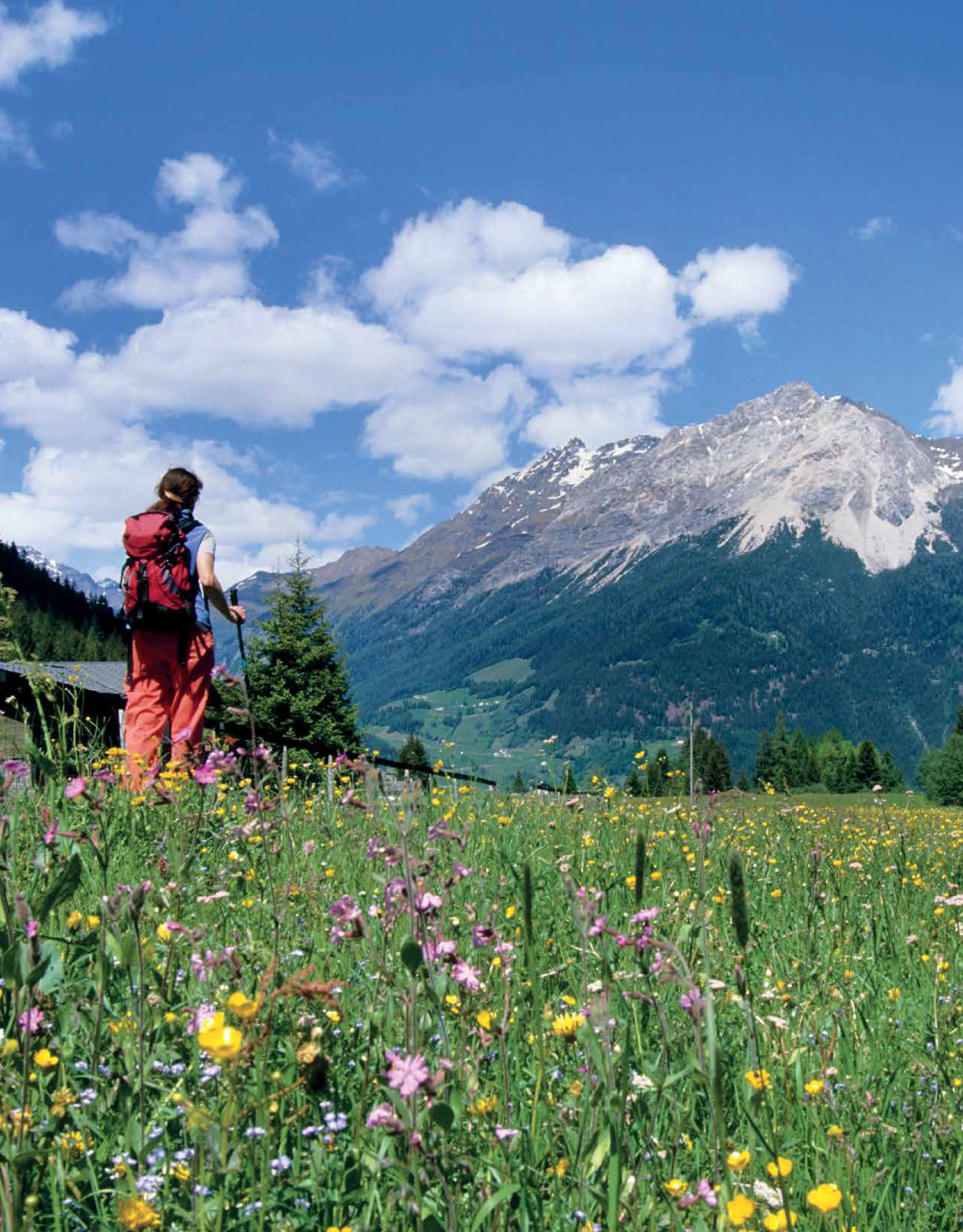
16
Each of these worldviews may be found among citizens of Canada today, but we can also trace a historical and gradual change in the way Canada has viewed the natural world. In fact, we can see these worldviews expressed in the ethical positions of many prominent environmental scientists, politicians, and citizens whose actions are associated with landmark events in environmental history. [infographic 1.9]
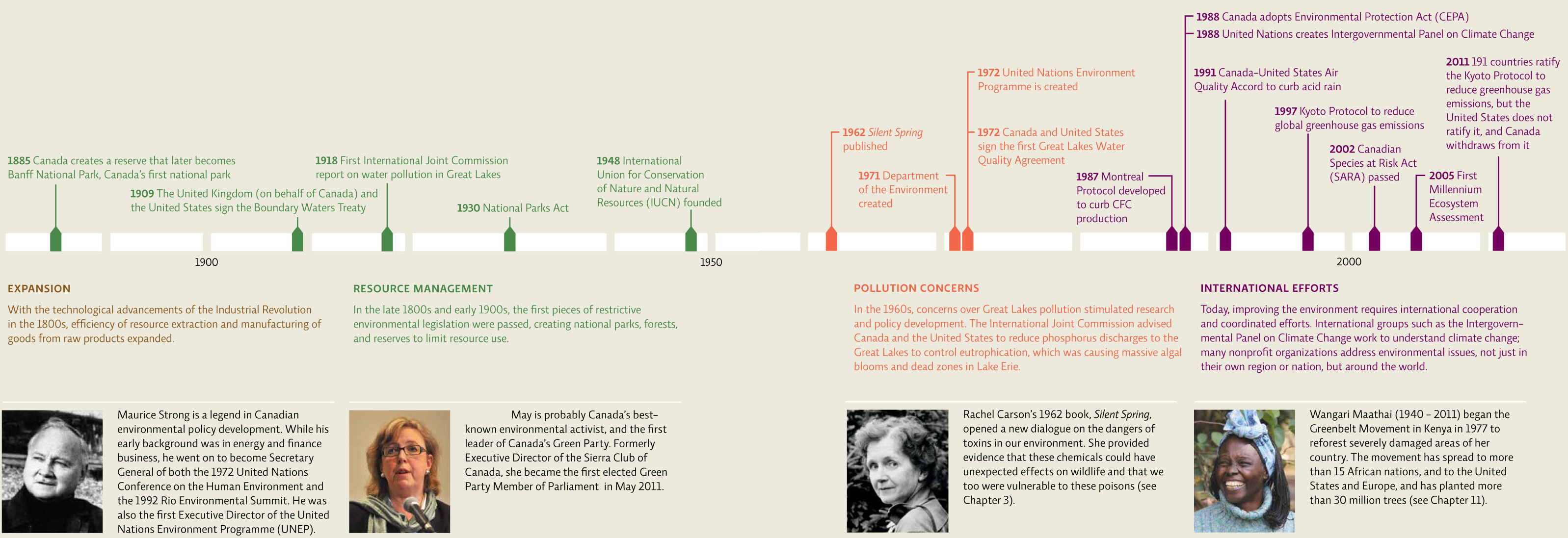
Back in Greenland, in the silt-covered ruins of a Viking farmhouse, archaeologists found the bones of a hunting dog and a newborn calf. The knife marks covering both indicate that the animals were butchered and eaten. “It shows how desperate they were,” says McGovern. “They would not have eaten a baby calf, or a hunting dog, unless they were starving.” By then, it was probably far too late for the Greenland Vikings to adapt in any meaningful way. Their tale had already been written—in ice cores and mud cores and in hundreds of years’ worth of midden heaps.
Our own story is being written now, in much the same way. But unlike our forebears, we still have enough time to shape our own narrative. Will it be dug up, a thousand years hence, from the ruins of what we leave behind? Or will it be passed down by the voices of our successors, who continue to thrive long after we are gone? Ultimately, the answer is up to us.
Select references in this chapter:
Benyus, J. 1997. Biomimicry. New York: William Morrow and Company.
Diamond, J. 2005. Collapse. New York: Viking Press.
McGovern, T. H. 1980. Human Ecology, 8: 245–275.
17
BRING IT HOME: PERSONAL CHOICES THAT HELP
The concept of sustainability unites three main goals: environmental health, economic profitability, and social and economic equity. All sorts of people, philosophies, policies, and practices contribute to these goals; concepts of sustainable living apply on every level, from the individual to the society as a whole. In other words, every one of us participates. Throughout this book, you will have the opportunity to learn about personal actions that can help address environmental issues but a good starting place is to learn about your own environment and the place you call home.
Individual Steps
 Discover your local environment. What parks or natural areas are close by? Does your campus have any natural areas? Visit one and spend a little time just observing nature and your own reactions. Write down your thoughts or share you experiences with a friend.
Discover your local environment. What parks or natural areas are close by? Does your campus have any natural areas? Visit one and spend a little time just observing nature and your own reactions. Write down your thoughts or share you experiences with a friend.
 Are there restaurants, grocery stores, or other retail venues accessible through public transportation or within walking distance of your campus or home? Try walking or riding a bus to these businesses instead of driving to others farther away for a week or two. Is this a reasonable option for you? Why or why not?
Are there restaurants, grocery stores, or other retail venues accessible through public transportation or within walking distance of your campus or home? Try walking or riding a bus to these businesses instead of driving to others farther away for a week or two. Is this a reasonable option for you? Why or why not?
Group Action
 Discover your own interests. There is a group for every interest—from outdoor recreation, wildlife viewing and preservation, and environmental education, to transportation and air-quality issues. Get involved with organizations working to improve environmental issues or address social change and human rights. One person can make a difference but a group of people can cause a sea change.
Discover your own interests. There is a group for every interest—from outdoor recreation, wildlife viewing and preservation, and environmental education, to transportation and air-quality issues. Get involved with organizations working to improve environmental issues or address social change and human rights. One person can make a difference but a group of people can cause a sea change.
Policy Change
 Discover what’s happening in your community. Read the newspapers and monitor blogs covering environmental and quality-of-life issues. Alert your local, regional, and national representatives about the issues you care about, and vote for government officials who support the causes you support.
Discover what’s happening in your community. Read the newspapers and monitor blogs covering environmental and quality-of-life issues. Alert your local, regional, and national representatives about the issues you care about, and vote for government officials who support the causes you support.
18